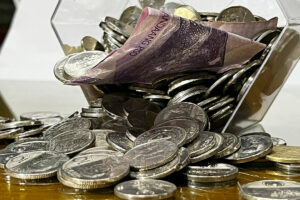




Policy Rate Updates: Double cut finale
 DOWNLOAD
DOWNLOAD

Monthly Economic Update: One for the road
 DOWNLOAD
DOWNLOAD

Inflation Update: Still low, still slow
 DOWNLOAD
DOWNLOAD


Gov’t debt yields go down

Yields on government securities (GS) traded in the secondary market went down last week following US consumer inflation data and the Philippine central bank’s decision to keep borrowing costs unchanged and signals about potential rate cuts as early as August.
Bond yields, which move opposite to prices, fell by 12.54 basis points (bps) on average week on week, based on PHP Bloomberg Valuation Service Reference Rates data as of May 17 published on the Philippine Dealing System’s website.
Rates mostly fell last week. Yields on the 182- and 364-day Treasury bills (T-bill) edged down week on week by 0.75 bp and 5.09 bps to 5.9006% and 6.0242%, respectively. Meanwhile, the 91-day T-bill went up by 1.73 bps to yield 5.7991%.
At the belly of the curve, yields on the two-, three-, and four-year Treasury bonds (T-bonds) declined by 6.93 bps (to 6.3587%), 8.55 bps (6.4016%), 10.48 bps (6.4335%), respectively. The five- and seven-year T-bonds also went down by 13.73 bps to fetch 6.468% and by 23.23 bps to 6.5373%, respectively.
At the long end, the 10-, 20-, and 25-year debt papers likewise saw their rates fall by 23.95 bps (to 6.6117%), 23.42 bps (6.6712%), and 23.53 bps (6.6706%) respectively.
GS volume traded rose to PHP 29.05 billion on Friday from PHP 8 billion a week earlier.
Bond yields moved lower as April US consumer price index (CPI) data were within market expectations while the US retail sales report fell short of estimates, a bond trader said.
“[These] data sent UST (US Treasury) yields lower, helping support the local GS market as it tracked the movement,” the bond trader said in a Viber message.
A second bond trader said the market responded positively to the government’s partial bond award last week as it showed some restraint on the Bureau of the Treasury’s (BTr) part to keep yields within market range.
The BTr raised just PHP 11.528 billion from the reissued 20-year bonds it auctioned off last week, lower than the PHp 30-billion program, despite total bids reaching PHP 36.703 billion.
The bonds, which have a remaining life of 14 years and eight months, were awarded at an average rate of 6.95%, while accepted yields ranged from 6.7885% to 6.994%
“With US CPI coming out lower than expected, this bolstered the market’s resolve and drove yields to rally by as much 30 bps,” the second trader said in a Viber message.
US consumer prices increased less than expected in April, suggesting that inflation resumed its downward trend at the start of the second quarter in a boost to financial market expectations for a September interest rate cut, Reuters reported.
Hopes of the Federal Reserve starting its easing cycle this year were further bolstered by other data on Wednesday showing retail sales were unexpectedly flat last month. The reports suggested that domestic demand was cooling, which will be welcomed by officials at the US central bank as they try to engineer a “soft landing” for the economy.
The consumer price index rose 0.3% last month after advancing 0.4% in March and February, the Labor department’s Bureau of Labor Statistics said.
In the 12 months through April, the CPI increased 3.4% after climbing 3.5% in March. Economists polled by Reuters had forecast the CPI gaining 0.4% on the month and 3.4% year on year. The annual increase in consumer prices has slowed from a peak of 9.1% in June 2022.
A separate report from the Commerce department’s Census Bureau showed retail sales unchanged in April after increasing 0.6% in March. Economists had forecast retail sales, which are mostly goods and are not adjusted for inflation, gaining 0.4%. Sales rose 3% year on year in April.
The first trader added that the Bangko Sentral ng Pilipinas’ (BSP) “less hawkish” tone at its meeting last week boosted buying interest, which resulted in lower GS yields.
The second trader said the market became more bullish after the BSP chief’s hints on rate cuts potentially starting by August, which would likely be ahead of the US Federal Reserve.
The Monetary Board on Thursday kept benchmark rates steady for a fifth straight meeting but signaled a “less hawkish” tone amid slower-than-expected inflation, with BSP Governor Eli M. Remolona, Jr. saying their easing cycle could begin with a 25-bp cut as early as August.
The BSP left its target reverse repurchase rate unchanged at a 17-year high of 6.5%, as expected by 17 out of 19 analysts in a BusinessWorld poll. Interest rates on the overnight deposit and lending facilities were likewise kept at 6% and 7%, respectively.
Mr. Remolona said they could cut rates by the third or fourth quarter this year. He said they expect one or two 25-bp rate cuts within the second semester.
The Monetary Board’s only meeting for the third quarter is scheduled for Aug. 15. Meanwhile, in the fourth quarter, it will hold reviews on Oct. 17 and Dec. 19.
For this week, the first bond trader said the market will look for more catalysts as the Fed has kept its cautious stance on rates following mixed data out of the world’s largest economy.
“We should see yields establish a range after the recent rally and take its cue from the BTr’s 20-year bond auction [this] week,” the second trader said.
The government will offer PHP 30 billion in new 20-year T-bonds on Tuesday. — By Abigail Marie P. Yraola, Deputy Research Head, with Reuters
This article originally appeared on bworldonline.com





 By BusinessWorld
By BusinessWorld